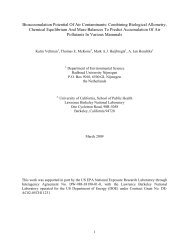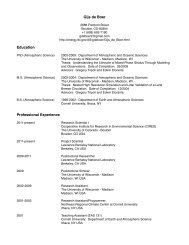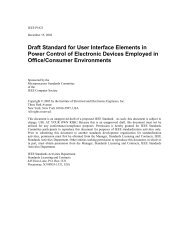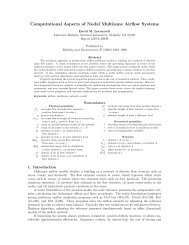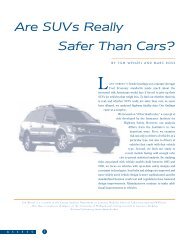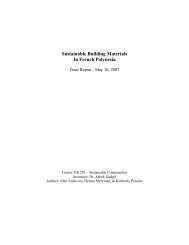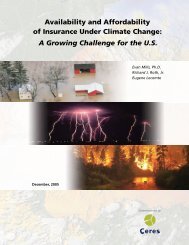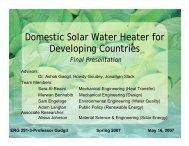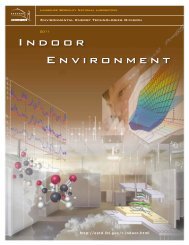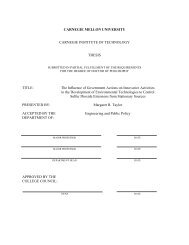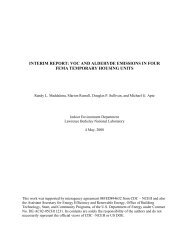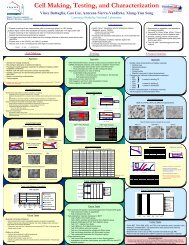indoor-outdoor air leakage of apartments and commercial buildings
indoor-outdoor air leakage of apartments and commercial buildings
indoor-outdoor air leakage of apartments and commercial buildings
You also want an ePaper? Increase the reach of your titles
YUMPU automatically turns print PDFs into web optimized ePapers that Google loves.
only 30 to 50 <strong>buildings</strong> clearly cannot hope to address this issue for every building type in the<br />
state. However, a carefully designed program could answer questions such as: do large<br />
<strong>buildings</strong> tend to be leakier or more <strong>air</strong>tight than small <strong>buildings</strong>, <strong>and</strong> do new <strong>buildings</strong> tend to<br />
be leakier or more <strong>air</strong>tight than old <strong>buildings</strong>?<br />
Sampling strategy for an experimental program<br />
Theoretically, the best way to estimate the relevant statistical distribution <strong>of</strong> apartment<br />
building <strong>leakage</strong> parameters would be to perform measurements in a simple r<strong>and</strong>om sample <strong>of</strong><br />
apartment <strong>buildings</strong> in California, weighted by occupancy (so that an apartment building that<br />
has more residents would be more likely to be sampled). Such a sampling strategy would be<br />
impractical, however, since it would require researchers to traverse much <strong>of</strong> the state in order to<br />
perform the experiments. The resulting travel costs, travel time, <strong>and</strong> housing costs would be<br />
enormous drains on the budget.<br />
A more realistic approach than a simple r<strong>and</strong>om sampling scheme would be to use a<br />
stratified sampling scheme. This might be rather complicated, but is nevertheless routine, <strong>and</strong><br />
many groups or consultants, such as the University <strong>of</strong> California's Survey Research Center, can<br />
define a complicated sampling scheme <strong>and</strong> determine the appropriate statistical weight to<br />
assign to each member in the sample.<br />
One possibility would be to select three or four small areas on which to focus. For<br />
instance, one county could be selected from urban coastal Northern California counties, one<br />
from urban coastal Southern California counties, one from the Central Valley, <strong>and</strong> one from the<br />
remaining counties in the State. A stratified r<strong>and</strong>om sampling system could be used to choose<br />
the counties, although in practice simply selecting them for convenience would probably yield<br />
adequate results. Within each county, researchers would attempt to make measurements in<br />
approximately 12 <strong>buildings</strong>, including at least 3 large new bUildings, at least 3 large older<br />
<strong>buildings</strong>, at least 3 small new <strong>buildings</strong>, <strong>and</strong> at least 3 small older <strong>buildings</strong>.<br />
Once the counties are selected, further spatial subdivsion is possible if desired, such as<br />
selecting (preferably at r<strong>and</strong>om) a portion <strong>of</strong> the county, such as a single town or city, from<br />
which a sample <strong>of</strong> apartment <strong>buildings</strong> is to be selected. City rental property records can then<br />
be consulted to create a list <strong>of</strong> rental <strong>buildings</strong> <strong>and</strong> the number <strong>of</strong> units in each. Buildings can<br />
be selected from this list, <strong>and</strong> their owners <strong>and</strong> occupants can be approached to determine<br />
willingness to participate, which in this case means (mostly) willingness to provide access.<br />
Logistical issues can be rather challenging, as a set <strong>of</strong> tenants must all be willing to provide<br />
access (for blower door installation, for example) at the same time on the same day.<br />
The effect <strong>of</strong> a stratified rather than simple sampling scheme is always to reduce the<br />
1/ efficiency" <strong>of</strong> the data: the statistical uncertainty in summary statistics (such as geometric<br />
mean <strong>and</strong> geometric st<strong>and</strong>ard deviation) is always larger with a stratified sampling scheme.<br />
The loss <strong>of</strong> efficiency cannot be quantified without detailed information about the sampling<br />
scheme, but for a scheme such as that discussed above, the efficiency might be about half that <strong>of</strong><br />
a simple r<strong>and</strong>om scheme. That is, a simple r<strong>and</strong>om sample <strong>of</strong> 20 <strong>buildings</strong> might yield the same<br />
statistical uncertainties as a 40-building sample collected according to the stratified scheme<br />
45



